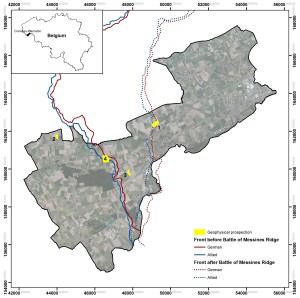
(Book chapter, 2016)
The archaeology of World War I in Comines-Warneton (Belgium) through aerial photographs and proximal soil sensing
We have developed an integrated aerial archaeological and GIS-aided approach to assess the Great War heritage, combined with landscape research and geophysical prospection. Preliminary results suggest an excellent subsurface preservation of the conflict landscape, even after the devastating effect of the war itself and a century of reconstruction and land use. A case study at Comines-Warneton compares data derived from contemporary World War I aerial photographs with recent multi-receiver electromagnetic induction surveys. In addition, as most research traditionally has been devoted to the study of the trench systems, this chapter focusses on some of the less-studied, but equally important, aspects of the conflict landscape. These are sites such as war cemeteries, hospital sites and gun emplacements. This methodology will form the foundation for a wider study of the entire Belgian front zone – the interdisciplinary research project ‘Non- Invasive Landscape Archaeology of the Great War in Belgium’.
Reference:
Gheyle, W., T. Saey, Y. Van Hollebeeke, S. Verplaetse, N. Note, J. Bourgeois, M. Van Meirvenne, V. Van Eetvelde and B. Stichelbaut (2016). The archaeology of World War I in Comines-Warneton (Belgium) through aerial photographs and proximal soil sensing. In: D. Cowley and B. Stichelbaut (eds.) Conflict Landscapes and Archaeology from Above. Farnham, Ashgate Publishing: 11-28. http://www.tandf.net/books/details/9781472464385/
About the book:
The study of conflict archaeology has developed rapidly over the last decade, fuelled in equal measure by technological advances and creative analytical frameworks. Nowhere is this truer than in the inter-disciplinary fields of archaeological practice that combine traditional sources such as historical photographs and maps with 3D digital topographic data from Airborne Laser Scanning (ALS) and large scale geophysical prospection. For twentieth-century conflict landscapes and their surviving archaeological remains, these developments have encouraged a shift from a site oriented approach towards landscape-scaled research. This volume brings together an wide range of perspectives, setting traditional approaches that draw on historical and contemporary aerial photographs alongside cutting-edge prospection techniques, cross-disciplinary analyses and innovative methods of presenting this material to audiences. Essays from a range of disciplines (archaeology, history, geography, heritage and museum studies) studying conflict landscapes across the globe throughout the twentieth century, all draw on aerial and landscape perspectives to past conflicts and their legacy and the complex issues for heritage management. Organized in four parts, the first three sections take a broadly chronological approach, exploring the use of aerial evidence to expand our understanding of the two World Wars and the Cold War. The final section explores ways that the aerial perspective can be utilized to represent historical landscapes to a wide audience. With case studies ranging from the Western Front to the Cold War, Ireland to Russia, this volume demonstrates how an aerial perspective can both support and challenge traditional archaeological and historical analysis, providing an innovative new means of engaging with the material culture of conflict and commemoration.